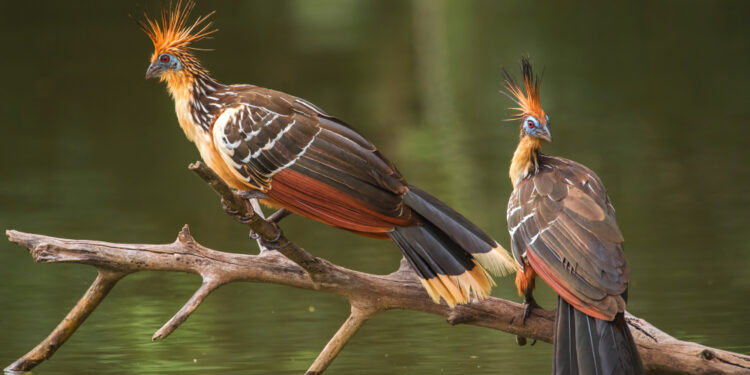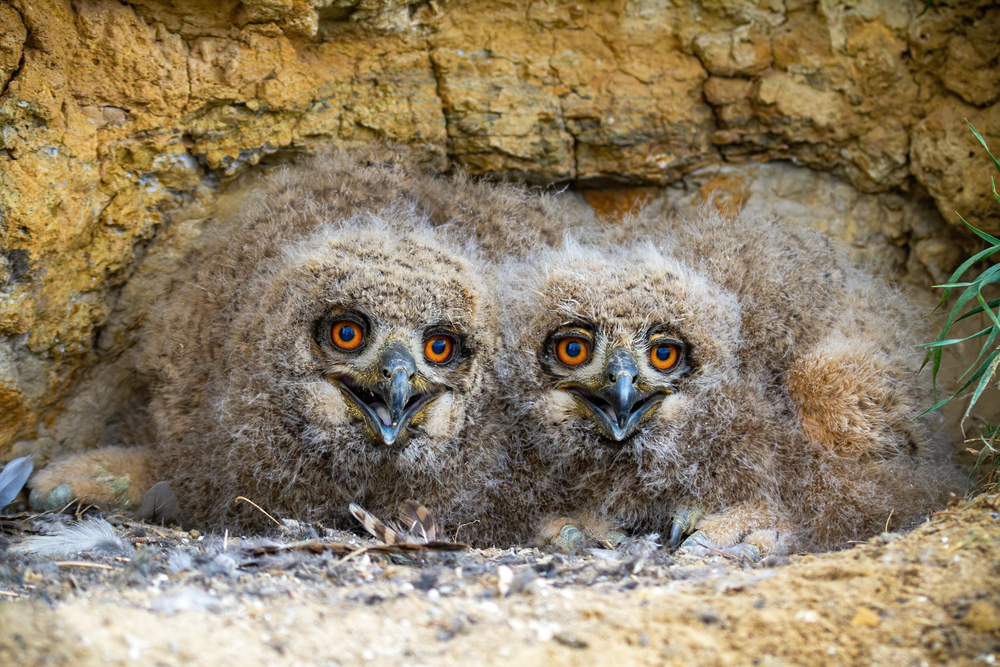In the heart of the Amazon Rainforest, amidst the vibrant and lush foliage, dwells a creature of remarkable peculiarity: the Hoatzin. Known as “Opisthocomus hoazin” in the world of science, this bird species exhibits a unique blend of characteristics that blur the line between avian and reptilian lifeforms, offering an enchanting glimpse into the world of prehistoric creatures.
Often referred to as the “Stinkbird” or “Canje Pheasant,” the Hoatzin stands out not only because of its striking appearance but also due to its unusual survival mechanisms. Covered in an array of russet, beige, and chestnut-colored feathers, the Hoatzin sports a spiky crest on its head, akin to a punk rocker’s hairstyle, lending it an air of distinguished nonconformity among its avian peers. However, it is the Hoatzin’s chicks that truly showcase this bird’s unique evolutionary path.
Unlike any other extant bird species, Hoatzin chicks are hatched equipped with a pair of functional claws on each wing. These reptile-like appendages, located on the bird’s first and second digits, enable these chicks to navigate the tangled branches and vines of the Amazonian canopy with ease. This evolutionary adaptation has garnered the Hoatzin substantial attention, likening it to the ancient Archaeopteryx, a prehistoric bird known as the “first bird,” which also bore similar claws on its wings.
The claws serve a crucial purpose in the survival of the Hoatzin chicks. Nests of Hoatzin birds are strategically situated over water bodies to deter predators. However, this arrangement presents a potential risk for the chicks if they fall or are startled into the water below. This is where the evolutionary marvel of the wing claws comes into play. The chicks use their claws to climb back up to the safety of their nests, providing them an invaluable defense mechanism in their vulnerable early life.
But the curiosities of the Hoatzin do not end with winged claws. The bird’s dietary preferences and digestion method are equally intriguing. Hoatzins are folivorous, feeding primarily on leaves, flowers, and fruits. They possess a highly specialized digestive system, analogous to that of ruminants like cows. Their unusually large crop facilitates foregut fermentation, a process that allows the bird to break down the complex fibers and toxins found in their leafy diet. This digestive peculiarity imparts a distinct odor to the Hoatzin, earning it the colloquial name, “Stinkbird.”
The Hoatzin’s vocalizations are as unique as its physical and biological traits. Their calls, a cacophonous blend of groans, hisses, and grunts, add an eerie soundtrack to the Amazon Rainforest, further setting them apart in the avian kingdom.
Despite its many oddities, the Hoatzin’s behavior is typical of many bird species. They live in small social groups and show a remarkable degree of cooperation in raising their young. The entire group participates in the care of the chicks, from feeding to protecting them from predators.
The Hoatzin, with its eccentric appearance and reptilian-like traits, is often described as a living fossil. Scientists believe this bird may be the sole survivor of a lineage that branched off over 64 million years ago. Its existence challenges the traditional understanding of avian evolution, prompting fascinating questions and stimulating further research.
Today, as the Amazon Rainforest faces increasing deforestation, the Hoatzin’s habitat is under threat. Conservation efforts are crucial to preserving this enigmatic species and the unique insights it offers into the ancient lineage of birds of birds.
The Hoatzin’s extraordinary traits serve as a vibrant testament to the rich biodiversity of the Amazon Rainforest, making it a compelling symbol of the need for comprehensive conservation strategies. The preservation of the Hoatzin’s habitat is not only a matter of safeguarding an individual species, but it also carries broader implications for the intricate web of life in the Amazon.
In the grand tapestry of evolution, the Hoatzin stands as a fascinating relic of an era long past. Its survival against the odds is a testament to its adaptability and resilience, traits that continue to astound scientists and enthusiasts alike. The Hoatzin’s unique story underscores the importance of every species in the global biodiversity puzzle, and the crucial role of ongoing conservation efforts in ensuring that future generations can continue to unravel these intricate biological mysteries.
In conclusion, the Hoatzin, with its winged claws and ancient lineage, serves as a poignant reminder of the wonders of evolution, the interconnectedness of life, and the urgent need for global conservation initiatives. As the sun sets over the Amazon Rainforest, the Stinkbird’s uncanny calls echo through the dense foliage, a haunting lullaby from a species that has weathered the test of time, offering a timeless melody of survival, adaptation, and the unending enigma of evolution.







